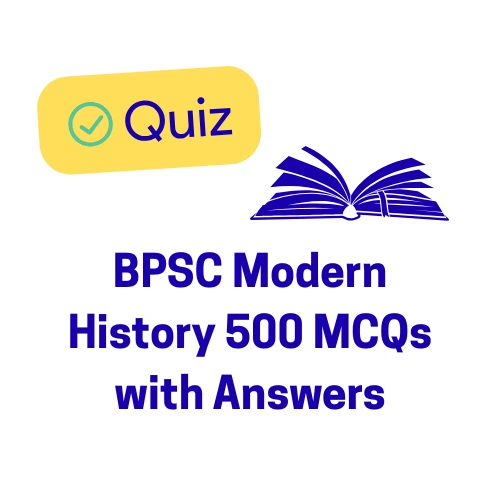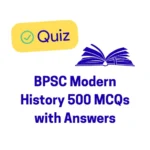BPSC Modern History Part 2 (500 MCQs) – (Carnatic Wars, Mysore, and Marathas)
BPSC Modern History Part 2 (500 MCQs)
Section C: Carnatic Wars and Anglo-Mysore Wars
Q31. The First Carnatic War (1746-1748) was an extension of which European conflict?
(A) Seven Years’ War
(B) War of the Spanish Succession
(C) War of the Austrian Succession
(D) Anglo-Dutch War
Q32. Which treaty concluded the First Carnatic War?
(A) Treaty of Pondicherry
(B) Treaty of Paris
(C) Treaty of Aix-la-Chapelle
(D) Treaty of Srirangapatnam
Q33. Which battle, fought during the First Carnatic War, established the superiority of a small, well-trained French army over the large, traditional Indian forces?
(A) Battle of Wandiwash
(B) Battle of Porto Novo
(C) Battle of Adyar (St. Thome)
(D) Battle of Ambur
Q34. The key factor that led to the French failure against the British in India was:
(A) The French Navy was weaker than the British Navy.
(B) The French Company (Compagnie des Indes Orientales) was state-owned and less entrepreneurial.
(C) The recall of Governor Dupleix at a crucial time.
(D) Poor financial condition of the French Company.
(E) More than one of the above
Q35. The Third Carnatic War ended with which treaty in 1763?
(A) Treaty of Aix-la-Chapelle
(B) Treaty of Paris
(C) Treaty of Pondicherry
(D) Treaty of Mangalore
BPSC Modern History Part 2 (500 MCQs)
Q36. The decisive Battle of Wandiwash (1760), which sealed the fate of the French in India, was fought between the British and the French. Who commanded the British forces?
(A) Robert Clive
(B) Sir Eyre Coote
(C) Major Stringer Lawrence
(D) General BussyAnswer
Q37. Which state in South India emerged as a prominent power under the rule of Hyder Ali and Tipu Sultan?
(A) Carnatic
(B) Hyderabad
(C) Travancore
(D) Mysore
Q38. The First Anglo-Mysore War (1767-1769) concluded with which treaty?
(A) Treaty of Mangalore
(B) Treaty of Madras
(C) Treaty of Srirangapatnam
(D) Treaty of Salbai
Q39. Who was the Governor-General of Bengal during the Second Anglo-Mysore War (1780-1784)?
(A) Robert Clive
(B) Lord Cornwallis
(C) Warren Hastings
(D) Lord Wellesley
Q40. Which of the following statements about Tipu Sultan is/are correct?
(1) He planted the ‘Tree of Liberty’ at Srirangapatnam.
(2) He was a member of the Jacobin Club.
(3) He introduced a new calendar, new coinage, and new scales of weight and measure.
(A) 1 and 2 only
(B) 2 and 3 only
(C) 1 and 3 only
(D) 1, 2, and 3
Q41. Hyder Ali died during which Anglo-Mysore War?
(A) First Anglo-Mysore War
(B) Second Anglo-Mysore War
(C) Third Anglo-Mysore War
(D) Fourth Anglo-Mysore War
BPSC Modern History Part 2 (500 MCQs)
Q42. The Third Anglo-Mysore War (1790-1792) concluded with the surrender of half of Mysore’s territory to the British and their allies. Which treaty marked this conclusion?
(A) Treaty of Madras
(B) Treaty of Mangalore
(C) Treaty of Srirangapatnam
(D) Treaty of Poona
Q43. Which British Governor-General’s policy of Subsidiary Alliance was responsible for finally incorporating Mysore into British control after the Fourth Anglo-Mysore War?
(A) Lord Cornwallis
(B) Lord Hastings
(C) Lord Wellesley
(D) Warren Hastings
Q44. After the Fourth Anglo-Mysore War, the state of Mysore was restored to the Hindu family of:
(A) Gaekwad
(B) Holkar
(C) Wodeyar
(D) Scindia
Q45. The Battle of Porto Novo (1781) saw the defeat of Hyder Ali by which British general?
(A) Sir Eyre Coote
(B) Hector Munro
(C) Arthur Wellesley
(D) Lord Lake
Section D: Anglo-Maratha Wars
Q46. The Maratha Confederacy rose to prominence under the leadership of:
(A) Peshwa Baji Rao I
(B) Balaji Vishwanath
(C) Nana Saheb
(D) Chhatrapati Shivaji
Q47. The First Anglo-Maratha War was concluded by which treaty?
(A) Treaty of Bassein (1802)
(B) Treaty of Salbai (1782)
(C) Treaty of Purandhar (1776)
(D) Treaty of Poona (1817)
Q48. Who was the Peshwa during the First Anglo-Maratha War?
(A) Baji Rao I
(B) Madhav Rao Narayan
(C) Baji Rao II
(D) Balaji Baji Rao (Nana Saheb)
Q49. The Second Anglo-Maratha War (1803-1805) was fought primarily because of the signing of which treaty by Peshwa Baji Rao II with the British?
(A) Treaty of Salbai
(B) Treaty of Bassein
(C) Treaty of Poona
(D) Treaty of Purandhar
Q50. The Peshwa system was finally abolished after the defeat of the Marathas in which war?
(A) First Anglo-Maratha War
(B) Second Anglo-Maratha War
(C) Third Anglo-Maratha War
(D) Battle of Panipat
Q51. Which Maratha chieftain was also known as ‘Macchiavelli of Maratha politics’ for his political shrewdness?
(A) Tukoji Holkar
(B) Mahadji Scindia
(C) Nana Fadnavis
(D) Malhar Rao Holkar
BPSC Modern History Part 2 (500 MCQs)
Q52. During the Third Anglo-Maratha War, the Peshwa Baji Rao II was defeated at which two major battles?
(1) Battle of Khadki
(2) Battle of Assaye
(3) Battle of Sitabuldi
(4) Battle of Koregaon
(A) 1 and 2 only
(B) 1 and 4 only
(C) 2 and 3 only
(D) 1, 3, and 4
Q53. Which region was annexed to the British territory after the final defeat and deposition of Peshwa Baji Rao II?
(A) Awadh
(B) Berar
(C) Poona and surrounding areas
(D) Punjab
Q54. After his deposition, the last Peshwa, Baji Rao II, was given an annual pension and sent to which place?
(A) Poona
(B) Calcutta
(C) Bithur (near Kanpur)
(D) Mysore
Q55. Which British Governor-General played a crucial role in dismantling the Maratha Confederacy and completing the conquest of the Maratha territories?
(A) Lord Cornwallis
(B) Lord Wellesley
(C) Lord Hastings (Moira)
(D) Lord Dalhousie
BPSC Modern History Part 2 (500 MCQs)
Q56. Which of the following Maratha houses accepted the Subsidiary Alliance after the Second Anglo-Maratha War?
(A) Scindia of Gwalior
(B) Holkar of Indore
(C) Bhonsle of Nagpur
(D) Gaekwad of Baroda
(E) More than one of the above
Q57. The Treaty of Poona (1817) was a part of the Third Anglo-Maratha War and virtually compelled the Peshwa to cede what to the British?
(A) The city of Poona
(B) His rights over the Malwa region
(C) His claim on the leadership of the Maratha Confederacy
(D) The Peshwa’s pension
Q58. The first British Resident to the court of the Peshwa at Poona was:
(A) John Malcolm
(B) James Grant Duff
(C) Mountstuart Elphinstone
(D) Charles Metcalfe
Q59. What was the main reason for the failure of the Maratha Confederacy against the British?
(A) Internal dissent and lack of unity among the Maratha chiefs.
(B) The superior military strategy of the British.
(C) Lack of a centralized, effective government after the death of Nana Fadnavis.
(D) The Maratha’s preoccupation with conflicts in the North.
(E) More than one of the above
Q60. Which of the following British-Maratha treaties is chronologically correct, from earliest to latest?
(A) Treaty of Salbai, Treaty of Purandhar, Treaty of Bassein
(B) Treaty of Purandhar, Treaty of Salbai, Treaty of Bassein
(C) Treaty of Bassein, Treaty of Purandhar, Treaty of Salbai
(D) Treaty of Purandhar, Treaty of Bassein, Treaty of Salbai

